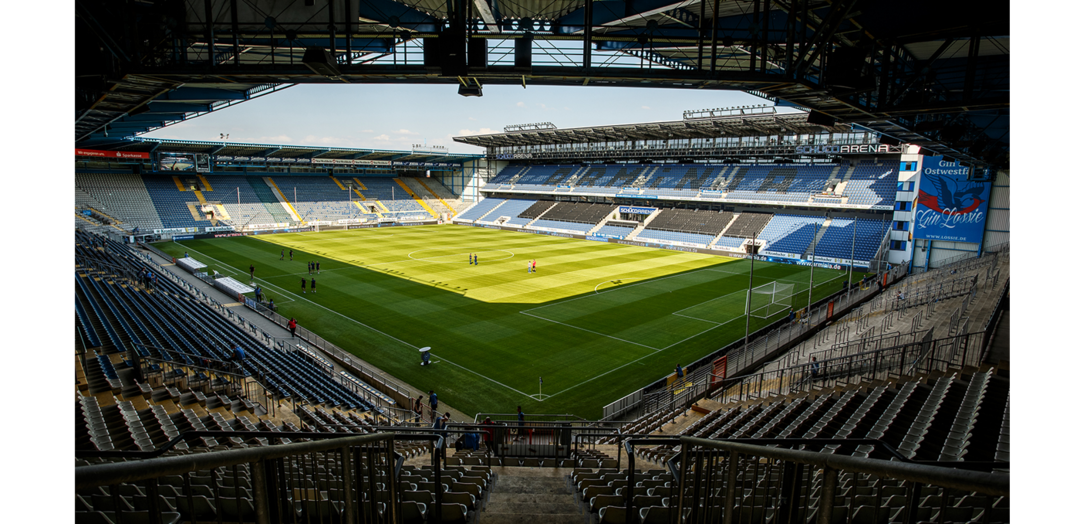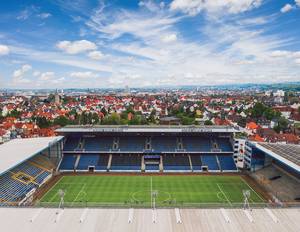
Q-SYS Scores for SchücoArena
[De] The Arminia Bielefeld soccer team has been playing their home games at SchücoArena in Bielefeld, Germany for almost a century. Through the decades their loyal fanbase grew and the stadium required multiple expansions to accommodate, today offering space for over 26,000 attendees. This trend of upgrades continued to include VIP boxes and even autism-friendly boxes for neurodivergent fans. Now with the Arminia Bielefeld’s recent promotion to the Bundesliga league, the stadium welcomes a new level of improvements to keep up with its success, which are manifesting as a Q-SYS led boost to their AV infrastructure.
The SchücoArena team commissioned the renewal and expansion of their sound system, in part to comply with the German Football League’s official requirements that a Bundesliga stadium must be improved yearly. The aim was to implement both the monitoring of the electroacoustic emergency warning system and the flexible control and distribution of audio signals inside and outside the stadium. To achieve this the team leaned on Beckhoff Technik und Design GmbH, led by project managers Alexander Hülshorst and Daniel Schulmeister, who have enjoyed a long partnership with SchücoArena as general media technology service providers.
For years Q-SYS formed the epicenter of the SchücoArena audio infrastructure, and from there has only been expanding. Built from two Q-SYS Core 510i processors that operate in master/replica mode, their solution enables complete control and monitoring of the stadium public address and voice alarm system. For example, the east stand voice alarm system is also the fire alarm during non-game operation – both of which are completely monitored within Q-SYS. To achieve this, the 100V signal from the system amplifiers is first converted into a balanced audio signal via a 100V-to-NF transformer and then fed into the Q-SYS system via a Q-SYS I/O-22 interface. In the system, the 40 Hz frequency of the AF signal is monitored by means of a pilot tone generator. Any fault messages that occur are stored, managed and transmitted as a collective fault message to the voice alarm system, which in turn is connected to the fire department's fire alarm control panel. Via Q-SYS TSC Series touch screen controllers, the occurring fault messages can be viewed individually from any location.
More recently, the audio and public address system was once again expanded. In addition to a new sound system for the main stand, loudspeakers were also installed outside the stadium. These integrated with the Q-SYS network infrastructure, including the aforementioned Q-SYS Core 510i, as well as Q-SYS CX-Q Series network amplifiers and a variety of Q-SYS I/O peripherals. Now audio data streams can be seamlessly distributed in and around the stadium via network switches to provide sound reinforcement for special events, summer parties and more. In addition, the Q-SYS Platform provides connectivity via Dante and AES67, which are used extensively for the press room and various business areas. "The official requirements can change very quickly. In the meantime, however, we have established a comprehensive network structure including a fiber optic connection to be able to react flexibly at any time," explains Daniel Schulmeister.
Alexander Hülshorst agrees, "We’ve prioritized our ability to deal with uncertainty. However, with Q-SYS, we also have the scalability to manage SchücoArena requirements for years to come." With processor utilization at a mere forty percent, the capacities of the two Q-SYS Core 510i in the SchücoArena are far from exhausted. With a great team and a solid formation in place, SchücoArena has achieved a winning, future-facing strategy with QSC.
Additional images:
